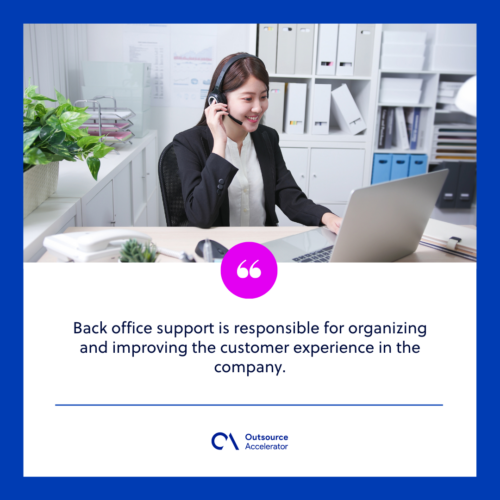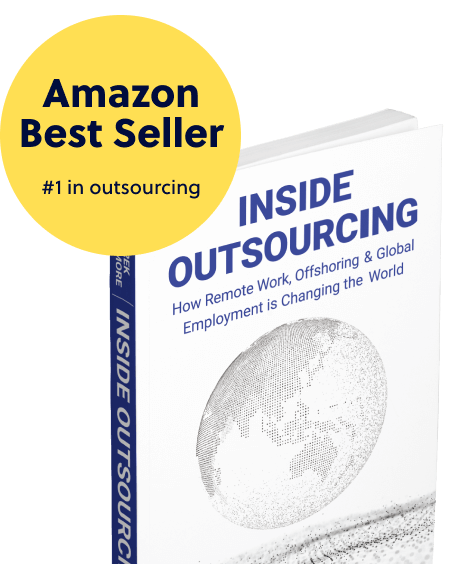Back Office
Definition
What is a back office?
Back office is a term used to classify business activities that are not directly attributable to frontline customer support, sales, and services.
Its functions relate to administrative functions that do not directly generate income or are accessed by customers but are necessary to streamline the other processes involved in a business.
The back office can be thought of as the non-customer-facing element of a business.
Back office tasks include but are not limited to the following: data entry, account processing, website content management, data verification, mediation, graphic design, writing and editing services, accounting and financial services, and quality assurance.
These functions are necessary to a business yet incur additional costs. Some companies find back office jobs costly because they require a substantial amount of capital for recruitment, salaries, and employee benefits.
The back office function is often described as ‘non-core,’ which means that it does not directly support or contribute to the achievement of the business’s financial or strategic objectives.
Although back office functions are often considered to be less strategic than front office roles, they are nevertheless essential for every business, large or small. The majority of back office tasks are performed by administrative staff and are therefore considered routine work.
Still, without the efforts of the back office, the organization would cease to operate properly, thus affecting the front office and overall customer satisfaction.
Back office employees typically do not interact directly with customers or clients. Instead, they handle internal operations that are often more complex than those handled by front-office personnel who deal directly with customers.
They are also responsible for ensuring that all company business functions run smoothly and efficiently.
Back office operations are typically highly repetitive, making them an ideal target for cost savings opportunities. However, the nature of this type of work makes it difficult to automate and streamline.
Automating these processes can be especially challenging because of their highly fragmented nature and the large number of different users involved. The result is that many back office processes are still performed manually.
To ensure that your manual back office processes are done efficiently, you can consider outsourcing.
Back-office functions
The back office is the cornerstone of any company’s financial and operational success. As a result, it often generates less revenue than the front office.
The traditional back office tasks are divided into two categories. These are the administrative operations that keep the firm functioning and the customer support functions that directly fulfill customer services and demands.
Modern back office functions are the behind-the-scenes tasks that support a company’s front-line operations.
These include operations such as supply chain management, procurement and logistics that are necessary to ensure an organization can meet customer demand in a cost-effective way.
Further, a modern back office model is one where all departments work together towards a common goal – delivering value to customers at the lowest possible cost.
In this model, no department is seen as more important than another, and none has more power than another either
The traditional approach to managing an organization involves separate departments focusing on their own specific goals with little consideration for what other departments may need from them or how their actions might impact others’ performance
These functions frequently carry out significant, multi-step processes in which more than one individual or functional group contributes to the fulfillment of the business process.
Administrative functions
Administrative back office functions are essential to the smooth running of any business. These roles include:
- Human resources
- Project management
- Accounting
- Legal
- Data entry
- Virtual reception
- Market research
- Inventory control
- Website management
- Basic admin duties
Customer support functions
Customer support is one of the most important back office functions in any business. It is a process that helps customers get answers to their inquiries, solve problems, and resolve issues with a company’s product or service.
These tasks include:
- Handling complaints and irate customers
- Providing information and answering questions about products or services
- Answering questions about payment plans and refunds
- Technical support
- Ensuring customer satisfaction
- Customer relationship management

What are back-office jobs?
A company’s back office operations are formed of several functions, and below are some examples of back office jobs and their key responsibilities:
Financial assistant
A financial assistant is in charge of assisting a company’s finance department. They are responsible for various tasks in the office, such as data entry, balance sheet generation, accounting, and keeping financial records up to date.
Because they mostly work on the company’s accounts, financial assistants must be detail-oriented, well-organized, and analytical.
The following is the updated 2023 salary comparison of paying for an in-house and outsourced financial assistant.
| Financial assistant | Monthly rate of Filipino staff | Monthly rate of in-house staff |
| Entry-level | $470 | $2,883 |
| Average | $630 | $4,069 |
| Experienced | $1000 | $5,700 |
(Sources: Talent.com, Indeed.com)
HR assistant
Human resource assistants are in charge of organizing appointments, keeping records, and onboarding new employees.
Among several other tasks, they handle payroll keep attendance records, and usually help the human resources manager. Employees in this field must be trustworthy, organized, and have effective communication skills.
Here is a quick comparison to see the difference between paying for an in-house and outsourced HR assistant.
| HR assistant | Monthly rate of Filipino staff | Monthly rate of in-house staff |
| Entry-level | $450 | $2,214 |
| Average | $640 | $2,992 |
| Experienced | $900 | $4044 |
(Sources: Talent.com, Indeed.com)
Data analyst
Data analysts are in charge of interpreting data, analyzing data, and putting data-gathering systems in place. They also create reports and provide assistance for the data warehouse.
Data analysts must be competent mathematicians with good problem-solving abilities and the capacity to manage information efficiently.
Here is a quick comparison to see the difference between paying for an in-house and outsourced data analyst.
| Data analyst | Monthly rate of Filipino staff | Monthly rate of in-house staff |
| Entry-level | $522 | $3,323 |
| Average | $641 | $5,091 |
| Experienced | $1,099 | $7,766 |
(Sources: Talent.com, Indeed.com)
Financial analyst
Financial analysts are in charge of various financial activities on behalf of external or internal clients. Their responsibilities include estimating operating expenses, producing reports, and maintaining a database.
In order to stay excellent in this job, applicants must be skilled mathematicians with great analytical abilities. It is also important to be kept updated on the latest developments in the field to determine how they could affect the firm’s financial records.
Here is a quick comparison to see the difference between paying for an in-house and outsourced financial analyst.
| Financial analyst | Monthly rate of Filipino staff | Monthly rate of in-house staff |
| Entry-level | $593 | $3,617 |
| Average | $733 | $5,148 |
| Experienced | $1,134 | $7,328 |
(Sources: Talent.com, Indeed.com)
Risk analyst
Risk analysts are back office employees who supervise investments and identify potential risks in a company’s investment portfolio.
Based on their review of these investments, they support the company by providing suggestions to corporations to assist in reducing future risks. Risk analysts must be skilled in analytical, strategic, and interpersonal abilities.
Here is a quick comparison to see the difference between paying for an in-house and outsourced risk analyst.
| Risk analyst | Monthly rate of Filipino staff | Monthly rate of in-house staff |
| Entry-level | $479 | $3,510 |
| Average | $631 | $5,510 |
| Experienced | $1,180 | $8,650 |
(Sources: Talent.com, Indeed.com)
Why is the back office important?
Back office services are simply the unseen but critical processes that make a business run.
The importance of back office services to any business cannot be overstated. Without these services in place, an organization will face financial consequences — whether it’s the inability to pay bills on time or having to pay employees late because payroll hasn’t been processed.
The back office is often overlooked when businesses focus on marketing and sales. However, the success of your organization depends on how well the back office runs.
Here are some reasons why it’s important:
- Revenue. The more efficiently you can run your business, the more money you’ll make. If operations are slow, it will take longer to receive payments from customers and vendors — which could impact cash flow.
- Staff productivity. Employees who don’t have to perform tedious tasks like data entry can spend more time on other projects that are important for growing your business or completing daily tasks.
- Efficiency. By having a back office support team, your core team doesn’t have to waste time manually inputting data into multiple programs or making phone calls just so that you can get things done quickly and accurately. Instead, all these kinds of tasks are done, handled, and maintained by a dedicated team!
- Customer service. A well-run back office means employees can focus on providing quality customer service, which will help maintain strong relationships with clients and create referrals for future business opportunities.
Back office support can be provided by third-party companies or outsourced entirely to save time and money by eliminating internal redundancies.
For instance, many online businesses hire virtual assistants (VA) to provide administrative and customer service assistance without having them physically present in the office.
This allows businesses to maintain contact with their customers without paying for an expensive location in an expensive city with expensive overhead costs like rent and utilities.
Back office support definition
Back office support is responsible for organizing and improving the customer experience in the company. Accurate data, clear and interesting content, and well-designed websites all contribute to a better customer experience.
Back office support is the term used to refer to the services provided by an organization to its customers, suppliers, and other business partners. It encompasses all the activities that take place in a company’s offices that are not directly related to its main products or services.
Back office support is the work that enables other people to do their jobs. It’s important because without it, no one will be able to do their jobs very well.
The back office is also called “administrative support” or “administrative services,” and it includes jobs like human resources, payroll, data entry, and accounting, among others.
Back office support jobs are frequently concealed behind the scenes. However, they should never be underestimated.
These roles help expand company demands and minimize friction from the customer experience for roles dealing with data input, content moderation, office services, and financial services.
A good back office support program can help you prevent unfavorable encounters at every point of interaction. Employees in back office roles are equally as important to excellent CX as those in front office positions, from multichannel services to order fulfillment.
Further, back office support can be broken down into two categories: Support for sales staff and support for other departments.

Support for sales staff
This includes administrative tasks such as keeping accurate records of sales and customer information, ordering supplies and equipment, managing budgets, and paying bills.
It also includes providing technical support for sales staff, such as answering queries about products or services and helping them resolve any problems that may arise during a sale.
Support for other departments
The back office provides all the non-customer-facing capacities that keep the business running smoothly. This includes financial operations, accounting, human resources, IT, and inventory management.
Basically, the back office is where the work is done. It’s where the staff are and where the support is provided.
In most businesses, the back office is where you’ll find most of the employees. It’s where your business happens.
Key benefits of outsourcing back office
With the advent of the internet age, companies can now take advantage of what we call Business Process Outsourcing (BPO). This business approach can lessen the operational costs of running back offices while maximizing its full benefits.
This also translates to more time for you and your core office team to focus on income-generating functions.
Outsourcing back office roles guarantees that you are working with skilled professionals minus the hassle and cost of recruitment, as well as other operational and employee benefit expenses.
There are several advantages to why businesses should outsource their back office functions:
Cost savings
Outsourcing your back office operations will help you reduce operational costs without impacting the quality of your services. You can also cut down on employee expenses such as office space and the cost of equipment.
Back office outsourcing can help you save money by reducing the need for expensive in-house personnel to perform these tasks. In addition, it gives you access to employees who specialize in these areas and have the expertise needed to handle them properly.
Time savings
Reducing costs means saving time too! You’ll spend less time on administrative tasks like data entry, filing taxes, and finding new vendors to do business with because all this will be handled by your outsourced provider.
Improved productivity
Back office outsourcing will allow you to focus on core business activities while leaving other roles to experts who have years of experience in handling such tasks.
This will help increase productivity levels at your company since they can now focus on their core responsibilities.
Focus on revenue-generating tasks
Back office outsourcing frees up entrepreneurs to spend more time working on revenue-generating activities such as sales and marketing, which will help them grow their businesses faster than ever before!
Higher quality services
Outsourcing companies have a lot of experience in providing back office services. They also have a large network of resources to draw from.
Your BPO provider can provide you with high-quality services at a lower cost than what it would be if you were to set up your own back office operations from scratch.
Where to find a back office outsourcing partner?
Thanks to the growing BPO industry, finding a back office outsourcing partner is easier these days. There are thousands of companies that have entered the business process outsourcing industry to accommodate clients who need specific skill sets in their business.
The good thing is they can be found in any country across the world — whether nearshore or offshore.
The Philippines is among the fastest-emerging outsourcing destinations in the world ever since its emergence in the 1980s. Their expertise in back office services, as well as numerous other roles, attracts global firms to their shores.
The country’s wide pool of BPO firms makes sure that their representatives are competent enough to handle the client’s needs.
Outsource Accelerator lists over 3,800+ business process outsourcing companies in the Philippines specializing in back office administration.







 Independent
Independent




